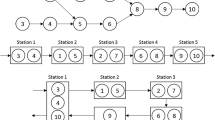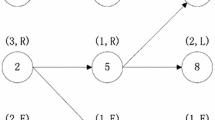Abstract
This article considers multi-manned assembly line balancing problems with walking workers. The objective of the problem is the minimization of number of workers and workstations simultaneously. Several exact-solution algorithms based on Benders’ decomposition are proposed to solve the problem optimally. In one of the algorithms a constructive heuristic that generates effective task-worker assignments and some problem-specific symmetry breaking constraints are used. Moreover, the solutions obtained by meta-heuristic in the literature are used as starting points to increase the performance of proposed decomposition methods. A benchmark set of 99 instances are used to analyze the performance of the proposed exact methods, contribution of the developed heuristic and the ability of Benders’ decomposition on improving the starting solutions. Our results indicate a significiant improvement in the optimal solvability of the problem for larger-sized instances. Suggested methods also improve the results of the meta-heuristic method for significant number of instances. Consequntly, proposed methods solved most of instances optimally and they are able to find the optimal solutions of 17 instances that cannot be solved optimally with previous methods.




Similar content being viewed by others
Availability of data and material
The datasets generated during and/or analyzed during the current study are available from the corresponding author on reasonable request.
Code availability
The C# programming code generated during the current study are available from the corresponding author on reasonable request.
References
Agussurja, L., Kumar, A., & Lau, H. C. (2018, April). Resource-constrained scheduling for maritime traffic management. In Thirty-Second AAAI Conference on Artificial Intelligence.
Akagi, F., Osaki, H., & Kikuchi, S. (1983). A method for assembly line balancing with more than one worker in each station. The International Journal of Production Research, 21(5), 755–770.
Akpinar, S., Elmi, A., & Bektaş, T. (2017). Combinatorial benders cuts for assembly line balancing problems with setups. European Journal of Operational Research, 259(2), 527–537.
Al-Zuheri, A., Luong, L., & Xing, K. (2012). The role of randomness of a manual assembly line with walking workers on model validation. Procedia CIRP, 3, 233–238.
Andreu-Casas, E., García-Villoria, A., & Pastor, R. (2022). Multi-manned assembly line balancing problem with dependent task times: A heuristic based on solving a partition problem with constraints. European Journal of Operational Research, 302(1), 96–116.
Azzam, S. R., Arias, L. C., & Zhou, S. (2011). Managing a manufacturing system with integration of walking worker and lean thinking. World Academy of Science, Engineering and Technology, 5(7), 925–927.
Bartholdi, J. J., III., & Eisenstein, D. D. (1996). A production line that balances itself. Operations Research, 44(1), 21–34.
Becker, C., & Scholl, A. (2009). Balancing assembly lines with variable parallel workplaces: problem definition and effective solution procedure. European Journal of Operational Research, 199(2), 359–374.
Benders, J. F. (1962). Partitioning procedures for solving mixed-variables programming problems. Numerische Mathematik, 4, 238–252.
Boozer, K. (2020). The Assembly Line. Science, Technology, & Society: A Student-Led Exploration.
Calzavara, M., Faccio, M., Persona, A., & Zennaro, I. (2021). Walking worker vs fixed worker assembly considering the impact of components exposure on assembly time and energy expenditure. The International Journal of Advanced Manufacturing Technology, 112(9), 2971–2988.
Cevikcan, E., Aslan, D., & Yeni, F. B. (2020). Disassembly line design with multi-manned workstations: A novel heuristic optimisation approach. International Journal of Production Research, 58(3), 649–670.
Chang, H. J., & Chang, T. M. (2010). Simultaneous perspective-based mixed-model assembly line balancing problem. Journal of Applied Science and Engineering, 13(3), 327–336.
Chen, Y. Y., Cheng, C. Y., & Li, J. Y. (2018). Resource-constrained assembly line balancing problems with multi-manned workstations. Journal of Manufacturing Systems, 48, 107–119.
Codato, G., & Fischetti, M. (2006). Combinatorial Benders’ cuts for mixed-integer linear programming. Operations Research, 54(4), 756–766.
Dimitriadis, G. (2006). Assembly line balancing and groupworking: A heuristic procedure forworkers’ groups operating on the same product and workstation. Computers & Operations Research, 33(9), 2757–2774.
Ebrahimi, M., Mahmoodjanloo, M., Einabadi, B., Baboli, A., & Rother, E. (2022). A mixed-model assembly line sequencing problem with parallel stations and walking workers: a case study in the automotive industry. International Journal of Production Research, 1–20.
Fattahi, P., Roshani, A., & Roshani, A. (2011). A mathematical model and ant colony algorithm for multi-manned assembly line balancing problem. The International Journal of Advanced Manufacturing Technology, 53(1–4), 363–378.
Furugi, A. (2022). Sequence-dependent time-and cost-oriented assembly line balancing problems: A combinatorial Benders’ decomposition approach. Engineering Optimization, 54(1), 170–184.
Hooker, J. N. (2000). Logic-based methods for optimization: Combining optimization and constraint satisfaction. Wiley.
Hooker, J. N., & Ottosson, G. (2003). Logic-based benders decomposition. Mathematical Programming, 96(1), 33–60.
Huang, D., Mao, Z., Fang, K., & Yuan, B. (2022). Combinatorial benders decomposition for mixed-model two-sided assembly line balancing problem. International Journal of Production Research, 60(8), 2598–2624.
Kazemi, A., & Sedighi, A. (2013). A cost-oriented model for balancing mixed-model assembly lines with multi-manned workstations. International Journal of Services and Operations Management, 16(3), 289–309.
Kellegöz, T. (2016). Balancing lexicographic multi-objective assembly lines with multi-manned stations. Mathematical Problems in Engineering, 2016, 1–20.
Kellegöz, T. (2017). Assembly line balancing problems with multi-manned stations: A new mathematical formulation and gantt based heuristic method. Annals of Operations Research, 253(1), 377–404.
Kellegöz, T., & Toklu, B. (2012). An efficient branch and bound algorithm for assembly line balancing problems with parallel multi-manned workstations. Computers & Operations Research, 39(12), 3344–3360.
Kellegöz, T., & Toklu, B. (2015). A priority rule-based constructive heuristic and an improvement method for balancing assembly lines with parallel multi-manned workstations. International Journal of Production Research, 53(3), 736–756.
Li, Z., Janardhanan, M. N., Tang, Q., & Ponnambalam, S. G. (2019). Model and metaheuristics for robotic two-sided assembly line balancing problems with setup times. Swarm and Evolutionary Computation, 50, 100567.
Lopes, T. C., Pastre, G. V., Michels, A. S., & Magatão, L. (2020). Flexible multi-manned assembly line balancing problem: Model, heuristic procedure, and lower bounds for line length minimization. Omega, 95, 102063.
Martello, S., & Toth, P. (1990). Knapsack problems: Algorithms and computer implementations. Wiley.
Michels, A. S., Lopes, T. C., & Magatão, L. (2020). An exact method with decomposition techniques and combinatorial Benders’ cuts for the type-2 multi-manned assembly line balancing problem. Operations Research Perspectives, 7, 100163.
Michels, A. S., Lopes, T. C., Sikora, C. G. S., & Magatão, L. (2019). A Benders’ decomposition algorithm with combinatorial cuts for the multi-manned assembly line balancing problem. European Journal of Operational Research, 278(3), 796–808.
Naderi, B., Azab, A., & Borooshan, K. (2019). A realistic multi-manned five-sided mixed-model assembly line balancing and scheduling problem with moving workers and limited workspace. International Journal of Production Research, 57(3), 643–661.
Pilati, F., Ferrari, E., Gamberi, M., & Margelli, S. (2021). Multi-manned assembly line balancing: Workforce synchronization for big data sets through simulated annealing. Applied Sciences, 11(6), 2523.
Rahmaniani, R., Crainic, T. G., Gendreau, M., & Rei, W. (2017). The Benders decomposition algorithm: A literature review. European Journal of Operational Research, 259(3), 801–817.
Roshani, A., & A. Roshani. (2012). “Multi-manned assembly line balancing problem: Minimizing cycle time. In: Proceeding of the IEE Asian Conference, Singapore.
Roshani, A., & Ghazi Nezami, F. (2017). Mixed-model multi-manned assembly line balancing problem: A mathematical model and a simulated annealing approach. Assembly Automation, 37(1), 34–50.
Roshani, A., & Giglio, D. (2017). Simulated annealing algorithms for the multi-manned assembly line balancing problem: Minimising cycle time. International Journal of Production Research, 55(10), 2731–2751.
Şahin, M., & Kellegöz, T. (2019a). Balancing multi-manned assembly lines with walking workers: Problem definition, mathematical formulation, and an electromagnetic field optimisation algorithm. International Journal of Production Research, 57(20), 6487–6505.
Şahin, M., & Kellegöz, T. (2019b). A new mixed-integer linear programming formulation and particle swarm optimization based hybrid heuristic for the problem of resource investment and balancing of the assembly line with multi-manned workstations. Computers & Industrial Engineering, 133, 107–120.
Scholl, A. (Ed.). (1999). Balancing and sequencing of assembly lines (pp. 6–18). Physica-Verlag Heidelberg.
Shewchuk, J. P. (2008). Worker allocation in lean U-shaped production lines. International Journal of Production Research, 46(13), 3485–3502.
Sikora, C. G. S. (2021). Benders’ decomposition for the balancing of assembly lines with stochastic demand. European Journal of Operational Research, 292(1), 108–124.
Sikora, C. G. S., Lopes, T. C., & Magatão, L. (2017). Traveling worker assembly line (re) balancing problem: Model, reduction techniques, and real case studies. European Journal of Operational Research, 259(3), 949–971.
Wang, Q., Owen, G. W., & ve Mileham, A. R. (2007). Determining numbers of workstations and operators for a linear walking-worker assembly line. International Journal of Computer Integrated Manufacturing, 20(1), 1–10.
Yadav, A., Kumar, S., & Agrawal, S. (2020). Reconfiguration of assembly line balancing–an automobile case study solved by the exact solution procedure. Benchmarking An International Journal, 28(5), 1576–1604.
Yilmaz, H., & Yilmaz, M. (2015). Multi-manned assembly line balancing problem with balanced load density. Assembly Automation, 35(1), 137–142.
Yilmaz, H., & Yilmaz, M. (2016). A multi-manned assembly line balancing problem with classified teams: A new approach. Assembly Automation, 36(1), 51–59.
Yilmaz, H., & Yilmaz, M. (2020). A mathematical model and tabu search algorithm for multi-manned assembly line balancing problems with assignment restrictions. Engineering Optimization, 52(5), 856–874.
Zakaraia, M., Zaher, H., & Ragaa, N. (2022). Solving stochastic multi-manned U-shaped assembly line balancing problem using differential evolution algorithm. International Journal of Production Management and Engineering, 10(1), 13–22.
Zamzam, N., & Elakkad, A. (2021). Time and space multi-manned assembly line balancing problem using genetic algorithm. Journal of Industrial Engineering and Management, 14(4), 733–749.
Zhang, Z., Tang, Q., & Chica, M. (2020). Multi-manned assembly line balancing with time and space constraints: A MILP model and memetic ant colony system. Computers & Industrial Engineering, 150, 106862.
Zhang, Z., Tang, Q., & Chica, M. (2021). A robust MILP and gene expression programming based on heuristic rules for mixed-model multi-manned assembly line balancing. Applied Soft Computing, 109, 107513.
Zhong, Y., Deng, Z., & Xu, K. (2019). An effective artificial fish swarm optimization algorithm for two-sided assembly line balancing problems. Computers & Industrial Engineering, 138, 106121.
Funding
No funding was received.
Author information
Authors and Affiliations
Corresponding author
Ethics declarations
Conflicts of interest
The authors whose names are listed above certify that they have no affiliations with or involvement in any organization or entity with any financial interest (such as honoraria; educational grants; participation in speakers’ bureaus; membership, employment, consultancies, stock ownership, or other equity interest; and expert testimony or patent- licensing arrangements), or non-financial interest (such as personal or professional relationships, affiliations, knowledge or beliefs) in the subject matter or materials discussed in this manuscript.
Ethical approval
The manuscript has not been submitted to another journal for simultaneous consideration. This work is original and has not been published elsewhere in any form or language. This study is unique and has not been split up into several parts to increase the quantity of submissions. Results have been presented clearly, honestly, and without fabrication, falsification or inappropriate data manipulation. The authors adhered to the discipline required by ethical rules in data collection, selection and processing. Required citations and statements taken from other studies are stated in accordance with ethical rules. Authors are sure they have permissions for the software used in the study. All procedures performed in studies involving human participants were in accordance with the ethical standards of the institutional and/or national research committee and with the 1964 Helsinki declaration and its later amendments or comparable ethical standards. The authors guarantee the accuracy of the above-mentioned statements and accept any liability and deprivation of rights that may arise.
Additional information
Publisher's Note
Springer Nature remains neutral with regard to jurisdictional claims in published maps and institutional affiliations.
Rights and permissions
Springer Nature or its licensor (e.g. a society or other partner) holds exclusive rights to this article under a publishing agreement with the author(s) or other rightsholder(s); author self-archiving of the accepted manuscript version of this article is solely governed by the terms of such publishing agreement and applicable law.
About this article
Cite this article
Şahin, M., Kellegöz, T. Benders’ decomposition based exact solution method for multi-manned assembly line balancing problem with walking workers. Ann Oper Res 321, 507–540 (2023). https://doi.org/10.1007/s10479-022-05118-z
Accepted:
Published:
Issue Date:
DOI: https://doi.org/10.1007/s10479-022-05118-z




